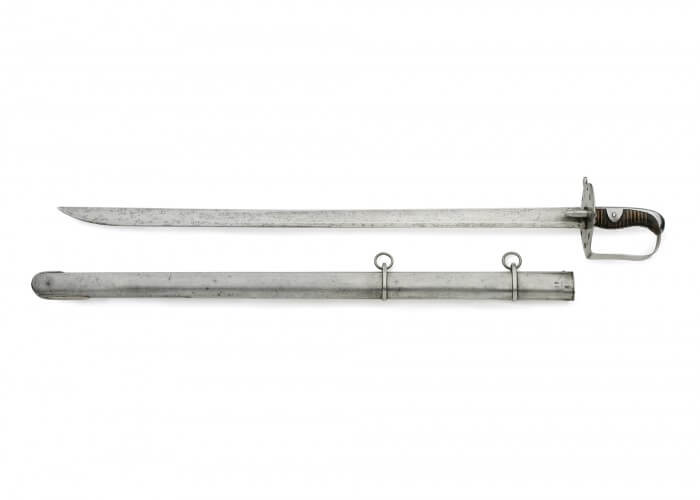
This is the sword of Sergeant Ewart of the 2nd Royal North British Dragoons, better known as the Scots Greys. Sergeant Ewart fought with exceptional courage and ferocity at the Battle of Waterloo, capturing a precious Eagle standard from the French. His sword is a 1796 pattern British heavy cavalry sabre.
It can be seen here @ the Royal Scots Dragoon Guards Museum
The 1796 pattern was a brutally heavy cavalry sword, specifically designed as a cutting weapon. Ewart’s sword, with its hatchet point design, is typical of those issued to the heavy cavalry. Their owners often modified the blades of these sabres and Ewart’s blade is no exception. There is evidence that some slight adjustments have been made to the cutting edge of his sword, which has been filed into a more pronounced point. This enabled the blade to be used for thrusting, as well as cutting.
Despite its clear cutting power, the 1796 sabre did have some disadvantages against its French cavalry counterpart. Primarily it was much shorter than the French sword. Coupled with the French preference for thrusting, this meant that Napoleon’s cavalrymen could strike their opponents long before the British could retaliate. However, in the hands of a consummate swordsman like Ewart, or Corporal Shaw of the Life Guards, the sword was a formidable weapon which more than challenged the French cavalry sabres advantage in length.
Nowhere is this more clearly illustrated than in Ewart’s account of his capture of the Eagle standard of the 45e Regiment de Ligne at the Battle of Waterloo. Ewart was appalled at the events surrounding the death of Cornet Kinchant, an unfortunate officer who was shot by a surrendering French officer and his retaliation was swift and final. He rode into the melee, located the French officer and struck off his head with a single strike.
A further testament to the devastating combination of Ewart’s strength and skill, and the 1796 sabre’s brutal power is illustrated by his description of events after his vengeance upon the French officer. Ewart rode deeper into the ranks of French infantry, where he came upon the standard-bearer of the 45e Regiment de Ligne. He parried the Frenchmen’s thrust before cutting his opponent down. A lancer then charged at Ewart, who again covered his opponents thrust before slashing up through the lancer’s teeth across his face. Finally a foot soldier discharged his musket at Ewart. Fortunately it missed its mark and as the infantryman charged with his bayonet, the Scotsman parried his opponent and cut him down before retiring with his prize. The capture of the Eagle and Ewart’s gallantry earned The Scots Grey’s the nickname of the “The Birdcatchers”